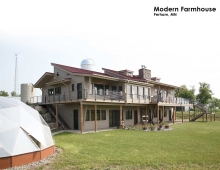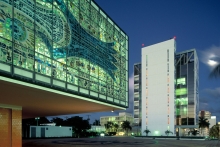Norway's TrollVeggen Restaurant
The Trollveggen made Architectural Digest's list of 10 most beautifully designed restaurants � read more about the visitor center and cafeteria elevated by its modernist architechture.
Reiulf Ramstad Architects designed a new tourist center and restaurant at the base of the Troll Wall, Europe�s tallest rock face. The form and material palette of the center mimics its stark landscape, and the resulting design is so dynamic it just might steal the show.
Tourist centers with restaurants are necessary and inevitable fixtures along scenic roadways. Usually they are utilitarian structures that peddle gaudy souvenirs and greasy food. However, in Norway, road-trippers have a more modern and elegant option when it comes time to make a pit-stop. The new tourist center situated at the base of Norway�s Troll Wall, or Trollveggen�Europe�s tallest vertical rock face, located in the Romsdal Valley along the western side of the country�is a welcome exception to this tired typology.











